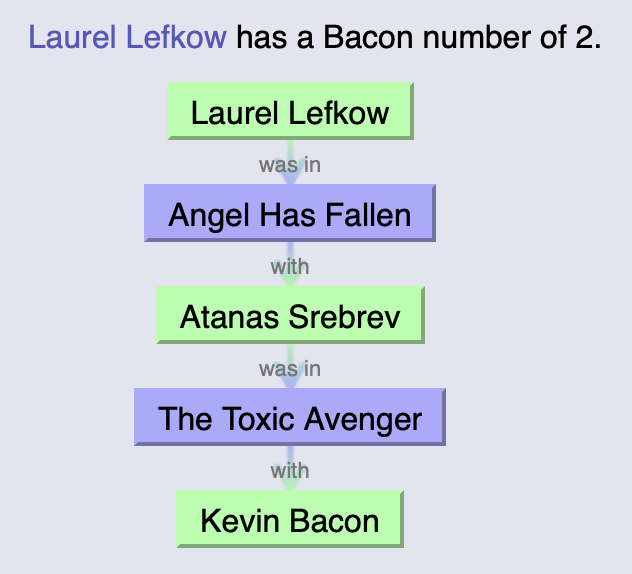I’m a big fan of random connections, so you will not be surprised to learn that one of my great unfulfilled ambitions is to have a Bacon number. You know, the number of links connecting you to the actor Kevin Bacon, based on who he has co-starred with over his career. I’ll state right from the off that this ambition is very likely to remain unfulfilled, because for one thing I’ve left it a bit late to make the attempt. More importantly, I am not an actor.
That said, the most obscure actor listed on IMDB – the late, great Anne Sellors – has a Bacon number of 3, so maybe there’s hope after all. Ms Sellors, famously, is only listed for a single role – “Woman Who Urinates on Herself (uncredited)” – in 1984’s Threads. I like to think that, subsequent to her appearance in Threads, she was approached by a string of Hollywood producers and turned every single one of them down in order to keep her CV pure.

You can easily find out any given actor’s Bacon number by using the excellent Oracle of Bacon website, and of course this does lead into temptation. Because every so often, I convince myself that, like Anne Sellors, I too have a Bacon number of 3. My argument is based on the fact that Laurel Lefkow, who read my story “The Amazing Arnolfini and His Wife” on BBC Radio 4, has an impressively low Bacon number of 2. You can tell me that just being the writer of a radio short story doesn’t count, but I may not choose to listen to you.

In any case, just having a Bacon number is a bit unambitious; the really cool kids have an Erdős – Bacon number. Paul Erdős was a mathematician who co-authored a daft number of papers in all branches of the subject and hence occupies the role of Kevin Bacon in the world of academic mathematics. Almost every mathematician worth their salt – along with several in related disciplines – has an Erdős number. However, having an Erdős – Bacon number is a little rarer. Natalie Portman has one (7), as does Colin Firth (6), along with the likes of Stephen Hawking (6) and Carl Sagan (also 6), so the bar to entry is quite high.
Now it happens that I do – sort of – have some skin in this game. As described elsewhere on this website, I have written two books that have been cited in learned academic papers, Professional DCOM Application Development and Mrs Darcy versus the Aliens. And yes, these do indeed show up on Google Scholar. Now I don’t know about you, but this makes me think that if a book can be cited in an academic paper, then books and papers are – sort of – equivalent. Which means that if I happened to have collaborated on a book with someone who has an Erdős number of n, I would have an Erdős number of n + 1, right?
Right?
As it happens, I can easily put my finger on someone I know who has an Erdős number (4, as it happens): Kevlin Henney. As well as being a renowned software expert, Kevlin is a writer of short fiction who has been in several anthologies that I’ve turned up in as well. Would that count?
I think that’s a bit flaky, to be honest. To suddenly flip from academe to flash fiction is a bit of a stretch. No, I think I need to choose a more technical book for my prospective co-author. This is easier than it might initially seem, because I’ve actually written odd chapters for a dozen software books. The most promising one appears to be Professional XML (Wrox, 2000).

Like the Oracle of Bacon, there is of course a site – CSAuthors – that enables you to find out any given person’s Erdős number. Whisper it quietly, but it’s actually a whole load better than the Kevin Bacon one, too. Not only that, but it also gives you your target’s Djikstra number, which is a kind of computer science version of their Erdős number, except that it gives you your collaborative distance from Edsger Djikstra, if that happens to float your boat.
Using this, I can establish that of my eleven co-authors, four potentially have Erdős numbers, although there is no way of immediately telling that they are indeed the same people and not just two different people with the same name. Indeed, I am immediately minded to discard Didier Martin (Erdős 4) because I can’t tie the one in Professional XML to the one on CSAuthors at all, and there seem to be more than one Didier Martin working in IT. Stephen Mohr (4) and Peter Stark (5) look more promising, but I still can’t make a definite connection.
However, Mark Birbeck (4) looks a lot more promising, as his papers listed on CSAuthors are very XML adjacent. So I’m going to claim that he is very much my co-author on Professional XML, meaning that I can – sort of – claim an Erdős number of 5, and hence an Erdős – Bacon number of 8. Sadly, even if this were to be regarded as remotely legit, it would still be one higher than the scores of every single individual mentioned on the Erdős – Bacon Wikipedia page.
Moving on from acting and academe, it struck me that no-one as far as I know has yet attempted to put together any kind of collaboration map for podcasts. Given the complete lack of official documentation, it would be a horrendous task to contemplate, although I guess it’s not beyond the bounds of possibility to consider putting together some kind of bot that would trawl the various pod hosting sites, digging out guest lists from the show notes. I’m not sure who would fulfil the Bacon / Erdős / Djikstra role here – probably some ghastly right-wing American – but we could sort that out later.
More importantly, I would immediately find myself a mere two links away from – for example – Robert Fripp and Robyn Hitchcock (via Andrew Male, my guest in episode 20 of It’s Lit But Is It Funny?, who also co-hosts the Mojo Record Club podcast) and Stephen Fry (via Andy Miller, my guest in episode 9 of ILBIIF, who also co-hosts Backlisted). I quite like that idea. Someone do this, please.